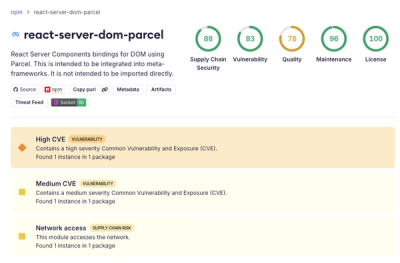
Temporary files, directories, and streams for Node.js.
Handles generating a unique file/directory name under the appropriate
system temporary directory, changing the file to an appropriate mode,
and supports automatic removal (if asked)
temp has a similar API to the fs module.
Node.js Compatibility
Supports v6.0.0+.

Please let me know if you have problems running it on a later version of Node.js or
have platform-specific problems.
Installation
Install it using npm:
$ npm install temp
Or get it directly from:
http://github.com/bruce/node-temp
Synopsis
You can create temporary files with open and openSync, temporary
directories with mkdir and mkdirSync, or you can get a unique name
in the system temporary directory with path.
Working copies of the following examples can be found under the
examples directory.
Temporary Files
To create a temporary file use open or openSync, passing
them an optional prefix, suffix, or both (see below for details on
affixes). The object passed to the callback (or returned) has
path and fd keys:
{ path: "/path/to/file",
, fd: theFileDescriptor
}
In this example we write to a temporary file and call out to grep and
wc -l to determine the number of time foo occurs in the text. The
temporary file is chmod'd 0600 and cleaned up automatically when the
process at exit (because temp.track() is called):
var temp = require('temp'),
fs = require('fs'),
util = require('util'),
exec = require('child_process').exec;
temp.track();
var myData = "foo\nbar\nfoo\nbaz";
temp.open('myprefix', function(err, info) {
if (!err) {
fs.write(info.fd, myData, (err) => {
console.log(err);
});
fs.close(info.fd, function(err) {
exec("grep foo '" + info.path + "' | wc -l", function(err, stdout) {
util.puts(stdout.trim());
});
});
}
});
Want Cleanup? Make sure you ask for it.
As noted in the example above, if you want temp to track the files and
directories it creates and handle removing those files and directories
on exit, you must call track(). The track() function is chainable,
and it's recommended that you call it when requiring the module.
var temp = require("temp").track();
Why is this necessary? In pre-0.6 versions of temp, tracking was
automatic. While this works great for scripts and
Grunt tasks, it's not so great for long-running
server processes. Since that's arguably what Node.js is for, you
have to opt-in to tracking.
But it's easy.
Cleanup anytime
When tracking, you can run cleanup() and cleanupSync() anytime
(cleanupSync() will be run for you on process exit). An object will
be returned (or passed to the callback) with cleanup counts and
the file/directory tracking lists will be reset.
> temp.cleanupSync();
{ files: 1,
dirs: 0 }
> temp.cleanup(function(err, stats) {
console.log(stats);
});
{ files: 1,
dirs: 0 }
Note: If you're not tracking, an error ("not tracking") will be passed
to the callback.
Temporary Directories
To create a temporary directory, use mkdir or mkdirSync, passing
it an optional prefix, suffix, or both (see below for details on affixes).
In this example we create a temporary directory, write to a file
within it, call out to an external program to create a PDF, and read
the result. While the external process creates a lot of additional
files, the temporary directory is removed automatically at exit (because
temp.track() is called):
var temp = require('temp'),
fs = require('fs'),
util = require('util'),
path = require('path'),
exec = require('child_process').exec;
temp.track();
var myData = "\\starttext\nHello World\n\\stoptext";
temp.mkdir('pdfcreator', function(err, dirPath) {
var inputPath = path.join(dirPath, 'input.tex')
fs.writeFile(inputPath, myData, function(err) {
if (err) throw err;
process.chdir(dirPath);
exec("texexec '" + inputPath + "'", function(err) {
if (err) throw err;
fs.readFile(path.join(dirPath, 'input.pdf'), function(err, data) {
if (err) throw err;
sys.print(data);
});
});
});
});
Temporary Streams
To create a temporary WriteStream, use 'createWriteStream', which sits
on top of fs.createWriteStream. The return value is a
fs.WriteStream with a path property containing the temporary file
path for the stream. The path is registered for removal when
temp.cleanup is called (because temp.track() is called).
var temp = require('temp');
temp.track();
var stream = temp.createWriteStream();
stream.write("Some data");
stream.end();
Affixes
You can provide custom prefixes and suffixes when creating temporary
files and directories. If you provide a string, it is used as the prefix
for the temporary name. If you provide an object with prefix,
suffix and dir keys, they are used for the temporary name.
Here are some examples:
"aprefix": A simple prefix, prepended to the filename; this is
shorthand for:{prefix: "aprefix"}: A simple prefix, prepended to the filename{suffix: ".asuffix"}: A suffix, appended to the filename
(especially useful when the file needs to be named with specific
extension for use with an external program).{prefix: "myprefix", suffix: "mysuffix"}: Customize both affixes{dir: path.join(os.tmpdir(), "myapp")}: default prefix and suffix
within a new temporary directory.null: Use the defaults for files and directories (prefixes "f-"
and "d-", respectively, no suffixes).
In this simple example we read a pdf, write it to a temporary file with
a .pdf extension, and close it.
var fs = require('fs'),
temp = require('temp');
fs.readFile('/path/to/source.pdf', function(err, data) {
temp.open({suffix: '.pdf'}, function(err, info) {
if (err) throw err;
fs.write(info.fd, data, (err) => {
console.log(err)
});
fs.close(info.fd, function(err) {
if (err) throw err;
});
});
});
Just a path, please
If you just want a unique name in your temporary directory, use
path:
var fs = require('fs');
var tempName = temp.path({suffix: '.pdf'});
Note: The file isn't created for you, and the mode is not changed -- and it
will not be removed automatically at exit. If you use path, it's
all up to you.
Testing
$ npm test
Contributing
You can find the repository at:
http://github.com/bruce/node-temp
Issues/Feature Requests can be submitted at:
http://github.com/bruce/node-temp/issues
I'd really like to hear your feedback, and I'd love to receive your
pull-requests!
Copyright
Copyright (c) 2010-2014 Bruce Williams. This software is licensed
under the MIT License, see LICENSE for details.





